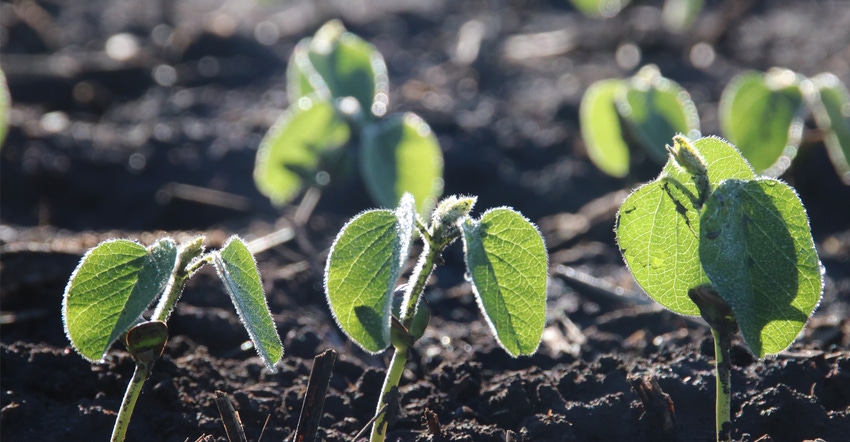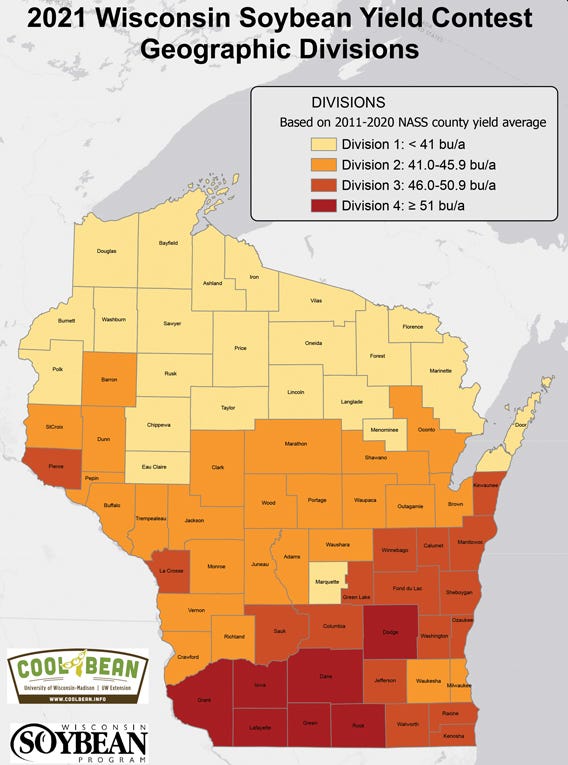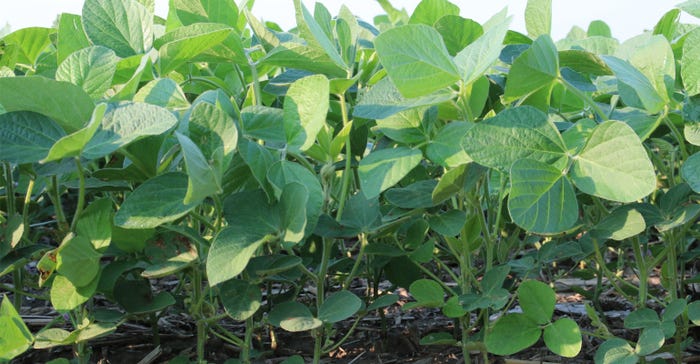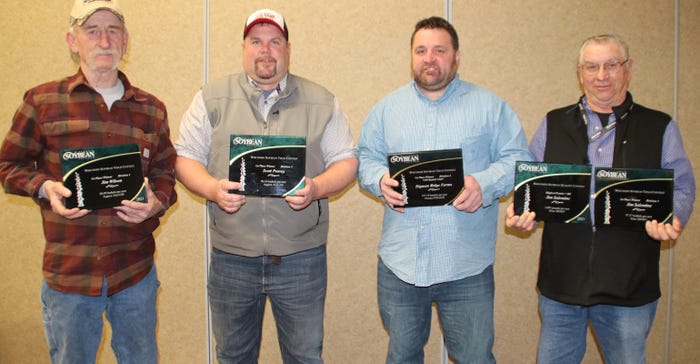March 22, 2022

Finishing a season with 100-bushel-per-acre soybean yields may seem like a pie-in-the-sky goal, but it happened last fall.
Shawn Conley, soybean specialist with the University of Wisconsin-Madison, says last year’s exceptional drought tolerance in the northern soybean crop illustrated that potential. In state yield tests for 2021, many fields and varieties were able to hit that triple-digit mark.
“This just shows what kind of genetic yield potential is in our soybeans. We had an amazing 23 soybean varieties equal or go above 100 bushels per acre,” he says. “It boils down to the management and weather that producers need to keep pushing us to that century target and beyond.”
Those high yields led to strong production numbers throughout the state, despite drought conditions for much of the year, particularly in western and southern Wisconsin. Conley notes that better weather, along with various input concerns surrounding fertilizer and corn, may make for another bin-busting year in 2022.
Although drought was prevalent for much of the Wisconsin growing season, Conley says the seed size found in much of the soybean crop was the reason for good drought tolerance. Average seed weights were 18.3 grams, nearly 11% greater than average.
He expects seed to remain larger in 2022 and tells producers to be prepared going into planting season. Some planter units may not be set up to handle a larger seed, meaning adjustments may be needed.
However, going for those high yields will contribute to an issue Conley noticed in last fall’s soybean crop. The quality of the beans has dipped, showing low protein content. He notes this is due to variety selection, as high-yielding varieties come at the expense of the coveted proteins. He says this is something the industry needs to address moving forward.
“While costs for planting or inputs may be higher this season, one place not to reduce costs is on varieties,” he adds. “There are a lot of deals out there, but varieties are not where you want to skimp. That genetic potential is what’s really going to drive yield on your farm.”
Record yield
In Division 4, Ron Digman from Mount Hope, Wis., harvested 107.19 bushels per acre in his 20-acre plot, which set an all-time record for the Wisconsin Soybean Association Yield Contest. The Grant County farmer seems to have learned that by having the right balance of inputs, teamed with his conventional and no-tillage program, soybeans can grow some impressive pods following corn that was chopped for silage last fall.
Digman Ridge Farms, located on Highway 18 about 5 miles from the Mississippi River, comprises about 800 acres, which includes corn and alfalfa along with 250 acres of soybeans. His contest plot of 20 acres consisted of a Fayette silt loam soil.
To ensure an adequate nutrient package, he uses variable-rate fertility based off soil samples taken by Black Sand Granary in Patch Grove, Wis. A 12-row planter dropped Pioneer 28A42X into 30-inch rows at 165,000 plants per acre on April 2. The total rainfall during the growing season was 18 inches. Beans were harvested on Oct. 10 at 11% moisture, with a final stand of 155,000 plants per acre.
To control grasses, waterhemp and other broadleaf weeds, the herbicide package included Fierce XLT at 3.2 ounces per acre and Roundup PowerMax at 32 ounces per acre. A second pass was made with XtendiMax at 22 ounces per acre plus another shot of Roundup PowerMax at 32 ounces per acre. Digman used Warrior insecticide at 2 ounces per acre. The foliar feeding was Yield On at 1.5 pints per acre, followed with a genetic fungicide, Quilt, at 10 ounces per acre at the R3 growth stage.
“I feel it’s imperative to plant as early as possible to get above-average yields,” he says. “Selecting a high-performing variety along with advice from my Pioneer agronomist, Matt Heims out of West Salem, helped lay the groundwork when trying to push production to the limit.
“In 2020 there was an opportunity to reach the century mark, but the area came up a little short on moisture, and some beans were lost during a couple of dry periods.”
Digman recalls he hadn’t even determined what part of the plot he was going to cut until a day or two before harvest. “I looked at some of the plants and thought they might not be as good as the 98.4 bushels per acre from 2020, which took second place in the district,” he notes. “But until the combine gets going, you just never know the final results.”
To be involved with the contest, participating growers must raise a minimum of 5 acres and then submit an entry for evaluation. Contestants may also select the best 5 acres in a soybean field larger than 5 acres and enter that variety. For reaching the century mark, Digman won a $2,500 check plus a plaque and $1,000 as the declared winner in his division.

Focusing on management
Scott Peavy from Woodville was the top grower in Division 2 with 98.34 bushels per acre. Family members in the 1,200-acre operation include his wife, Katy; two sons, Ben and Landen; his father, Bill; his father-in-law, Tom Rock; and a full-time employee, Terry Larson. A couple of years ago his entry notched second in the area.
Besides soybeans, the family raises corn and alfalfa for their 50 to 60 head of beef cattle and prefer using conventional tillage. By following a strict rotation over the past five years, their 500 acres of beans have averaged 75-plus bushels per acre.
The 20-acre contest plot, consisting of a clay loam soil, followed a corn and pasture rotation. Peavy dropped 140,000 seeds per acre of Asgrow 11X8 variety in 30-inch rows with an eight-row John Deere 1760 planter. Beans were harvested in early October at 13% moisture with a final stand of 139,000 plants per acre.
The St. Croix County farmer, located 40 miles east of St. Paul, Minn., points out that weather, which played a significant role in the total amount of growing degree days, was a major factor for achieving his nearly 100-bushel-per-acre yield. Receiving long days of sunshine, which contributes to more photosynthesis, greatly influences plant growth and pod size.
“Making sure there is an adequate micronutrient package, especially calcium and zinc, teamed with a heavy application of 1 ton of solid manure per acre and using a land roller, helped the overall average on that plot,” he says. “Since I began entering the contest, I try to pinpoint how my overall management practices are working year to year. By monitoring them, I’m able to tweak certain items or even discard them in order to help put more soybeans in the bin. For example, next year I’m going to up the population back to 160,000 plants per acre.”
Double winner
Salentine Homestead Dairy LLC claimed first place in Division 3 with a yield of 97.54 bushels per acre. The winning total was nearly 19 bushels higher than the farm’s average of 78 bushels per acre over the past five years.
Kewaunee County farmer Jim Salentine has entered the contest seven times, garnering three seconds and now three top finishes. And, for the 2021 competition, he also achieved the highest protein and oil content in the state with 3,085 pounds per acre, just 55 pounds below the winning total for 2020.
Salentine tills 580 acres and milks 240 head of Holsteins with his wife, Mary; son Josh and his wife, Jenny; and their children, Calba, Megan and Molly, on the sixth-generation farm near Luxemburg. They practice a rotation of alfalfa, corn, soybeans and wheat, and normally use conventional tillage on their Hortonville soils, which are deep and well drained. For the past three years, they also have put in 40 to 50 acres of cover crops, which includes barley, turnips and radishes, and follow that mix with corn the next growing season.

Salentine planted his 30-acre contest plot with Stine variety 20EB23 LibertyLink soybeans using a six-row John Deere unit outfitted with row cleaners. He dropped 140,000 seeds per acre in 30-inch rows. The moisture content at harvest on Oct. 16 averaged 16%, with a final stand of 130,000 plants per acre.
“I began planting on April 24, and it turned cold and wet,” he recalls. “There was little to no emergence for 10 to 12 days, so I went over the field with a rotary hoe to break up the surface crust. In the next 24 hours it rained nearly a half-inch.”
The seed was inoculated and there were two fungicide and one insecticide applications during the growing season. That package was Bio+ and N-Force pre-inoculate. Foliar feeding was done at the R1 to R3 growth stage with a Hardi sprayer and 60-foot boom. Ingredients on the first pass were 4 ounces of Prosper, 8 ounces of Plant Builder and 1 quart of Launch per acre. The second application included 1 quart of YieldMaster Solutions, 4 ounces of Plant Builder, 1 quart of SuperB+ and 3 ounces of BaythroidXL per acre.
“Timely rains in mid-July and late August totaling 6 inches combined with those two passes of foliar feeding when the plants were flowering helped boost the overall pod count by 25%,” Salentine says. “Weekly scouting from Mike Headt of Bio Mass in Green Bay also paid dividends. I tried everything to reach the century mark on the beans, but I’m extremely pleased with 97-plus bushels per acre.”
Consistent results
This was the second year Jim Wilson from St. Croix Falls entered the soybean yield contest. He topped Division 1 with 80.09 bushels per acre, while his son, Josey, was runner-up for that area with 76.15 bushels. The Polk County farmer took second in 2020 with 71.74 bushels per acre with Asgrow 10X9.
The Wilsons farm 2,500 acres, split near 50% in a corn-soybean rotation. The contest plot, featuring Cushing clay loam soil, covered 35 acres. Prior to planting in late April, Wilson applied 150 pounds of potassium and 75 pounds of AMS per acre. He planted Asgrow 11X8 variety with a 31-row 3650 Kinze unit in 15-inch rows, dropping a population of 135,000 seeds per acre. Soybeans were harvested Oct. 2 at 11% moisture with a final stand of 120,000 plants per acre.
In mid-June he made one pass with glyphosate at a rate of 1 quart per acre. No seed-applied inoculants, foliar feeding or fungicide treatments were used during the growing season. The toughest weed challenge to deal with nearly every year is waterhemp, Wilson notes.
“Choosing a variety that fits our soil type, always trying to take advantage of that early planting window, making sure fertility levels are adequate, and maintaining the pH level between 6.5 to 7 on the ground are the keys for us to achieving an excellent, consistent yield,” he says. “This past year was overcoming some stress due to a lack of moisture in June.
“I learned about the contest in the Wisconsin Agriculturist magazine two years ago and thought this would be a good project to try in our operation,” Wilson adds. “It certainly turned out to be an enjoyable, worthwhile perk and pleasant surprise to receive first place.’

Guidelines for entering 2022 soybean contest
Conley shares a list of guidelines for entering the 2022 Wisconsin Soybean Association Yield Contest. He notes the contest is sponsored by the association and the Wisconsin Soybean Marketing Board.
The contest was organized to encourage the development of new and innovative management practices, as well as to show the importance of using sound cultural practices in soybean production.
Any sound soybean production system can be entered in the contest. Two winners will be selected from each of four geographical divisions in Wisconsin. Each division is based on 10-year county soybean averages.
There are several guidelines to follow for the contest:
To qualify for the 2022 contest, entrants must be at least 14 years old on Aug 1.
More than one person in a family can enter, but each person must have a separate entry form and pay the fee.
Any individual contestant may enter more than one entry in the contest.
The contest field must be in Wisconsin.
The contest entry must be at least 5 continuous acres of one variety. Contestants may select the best 5 acres in a soybean field larger than 5 acres.
The variety that is originally entered must be the same variety that is reported on the harvest report form.
The land entered in the contest must be owned or leased by the entrant.
The variety entered must be commercially available.
There is a $25 fee (personal check) for each entry, which can coincide with the harvest date.
A supervisor’s name, title, address and telephone number must be on the contest entry form. The supervisor is responsible for overseeing all computations and field measurements, and must be present during harvest, weighing and moisture testing.
The contest entry must be harvested in acceptance with the harvest procedures set forth by the Wisconsin Soybean Association.
Harvest report forms must be completed and sent to Conley postmarked no later than seven days after harvest or Dec. 15, whichever date is earlier.
It’s the responsibility of the entrants to see that harvest report forms are properly completed and mailed by the deadline.
Producer recognition
Plaques and cash prizes will be awarded to the first-place ($1,000) and second-place ($500) winners in each geographical division. The winner is the entry that has the highest soybean yield based on bushels per acre at 13% moisture. Also, growers in the state who achieve 100 bushels or more per acre in the contest will be awarded a $2,500 check.
Each entrant is eligible to win only one plaque and cash prize. To review other contest entry qualifications, visit coolbean.info or email Conley at [email protected].
About the Author(s)
You May Also Like




